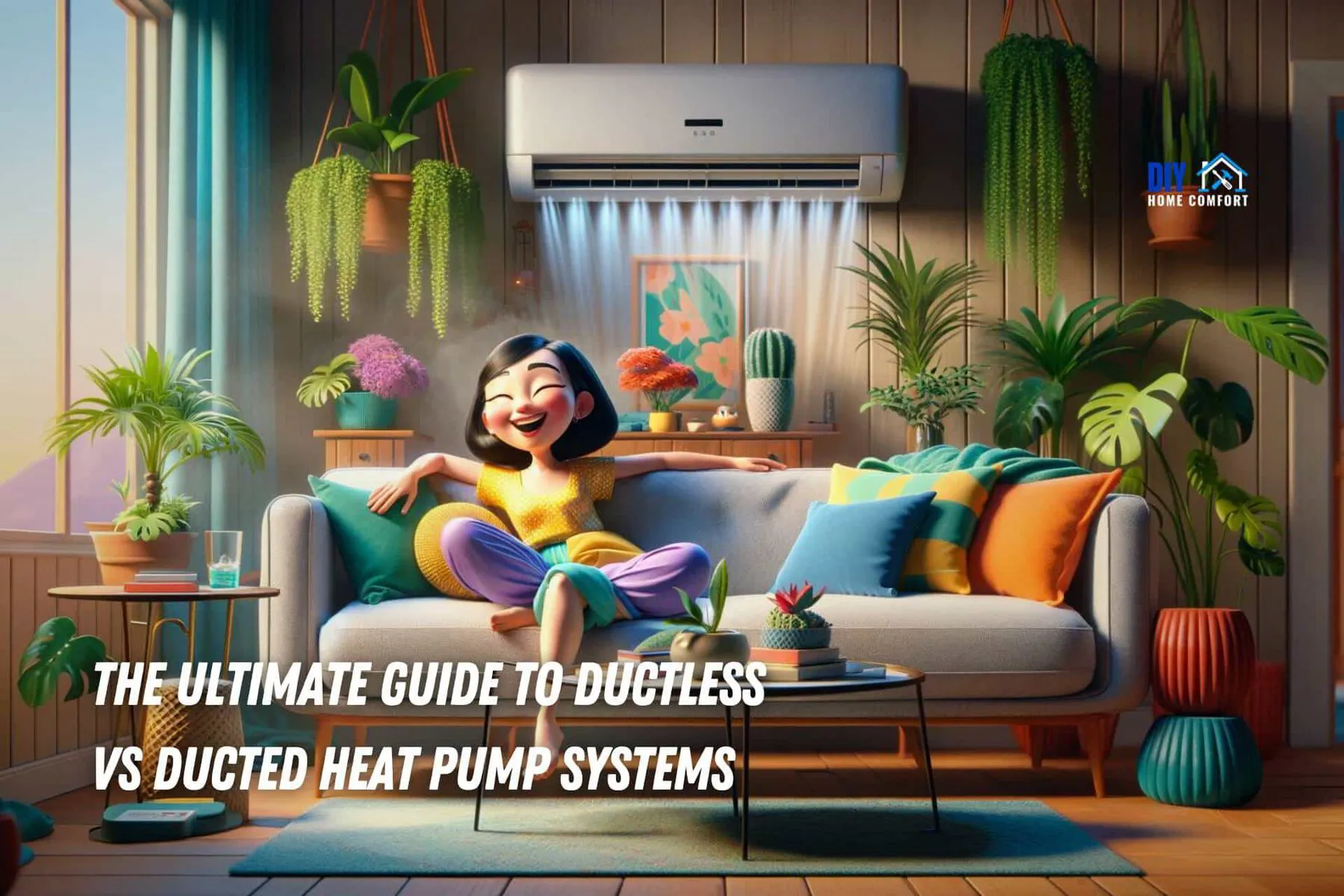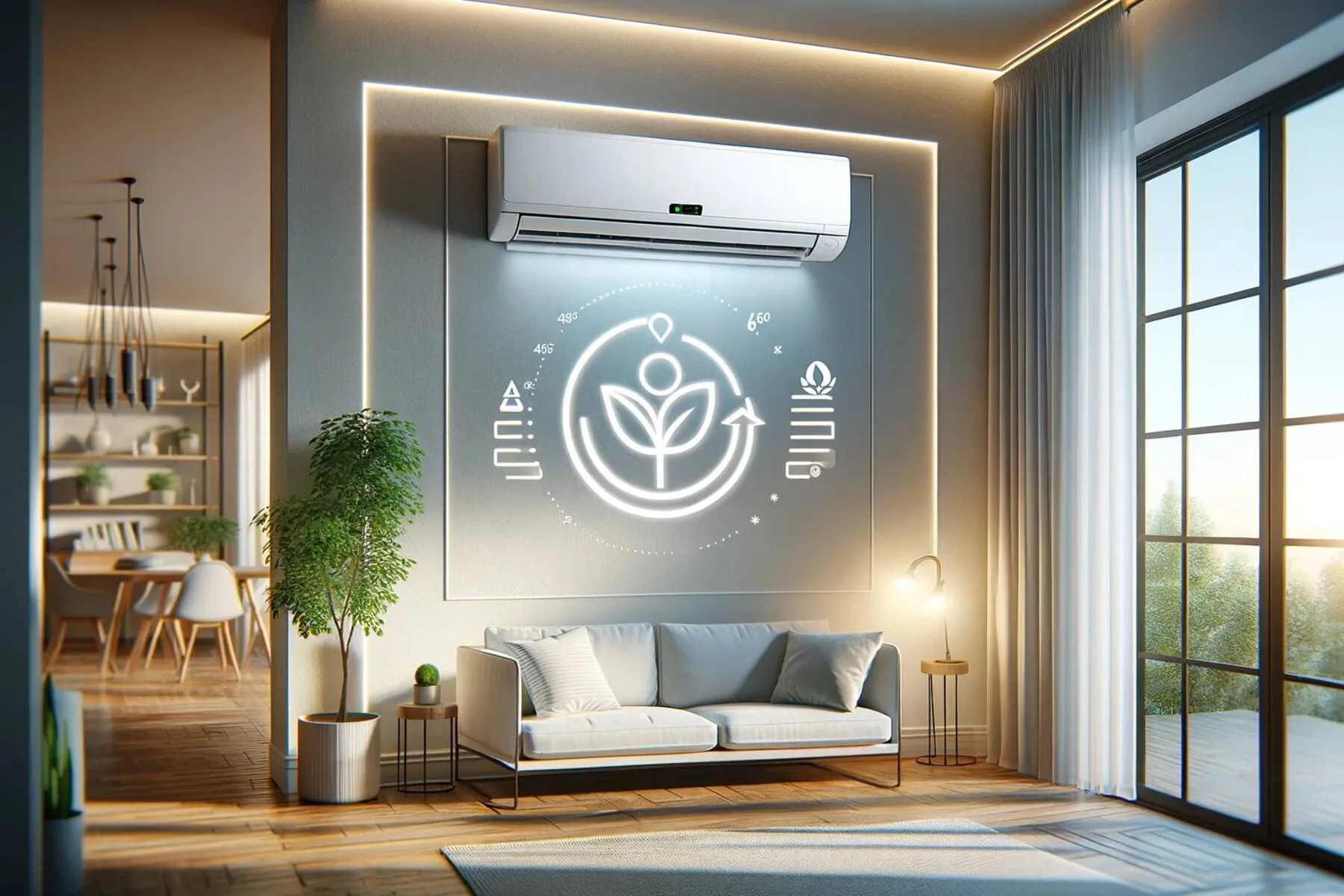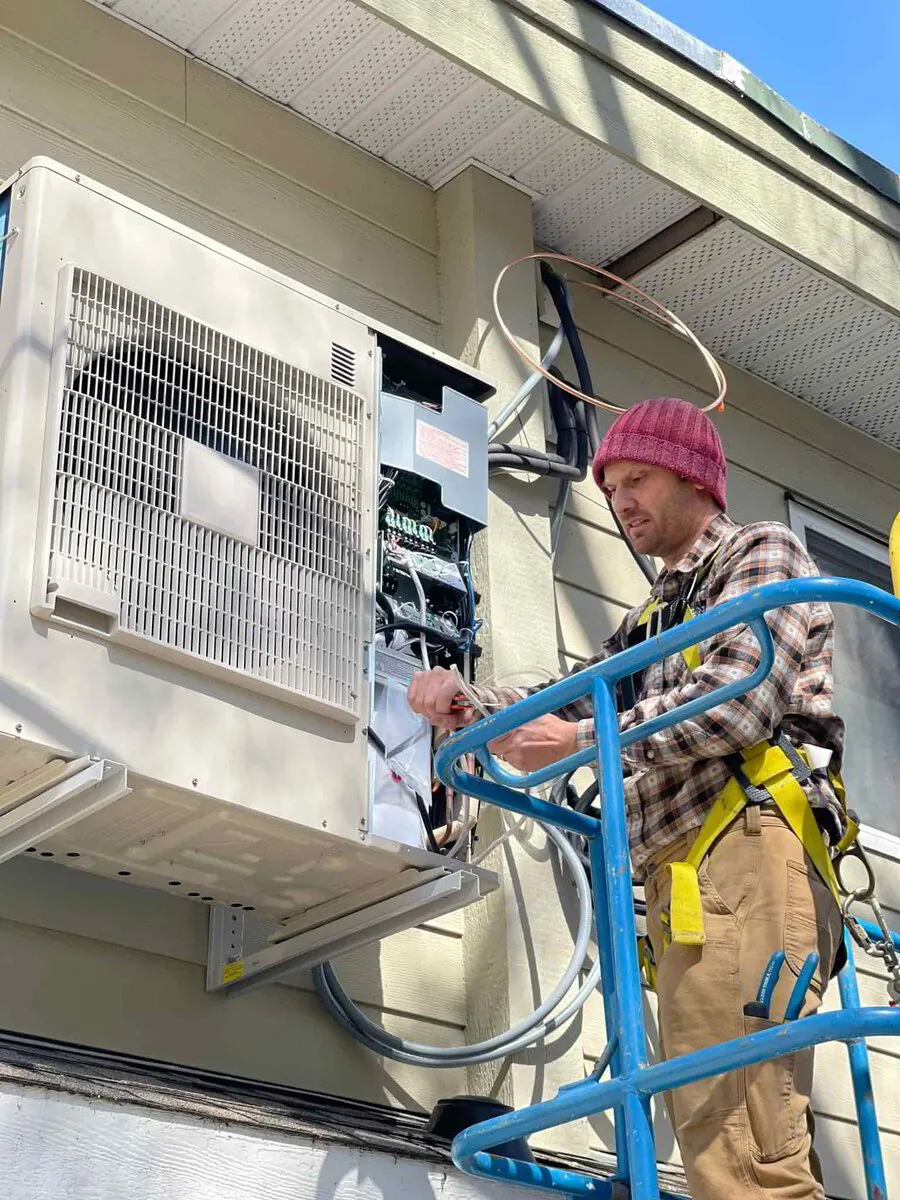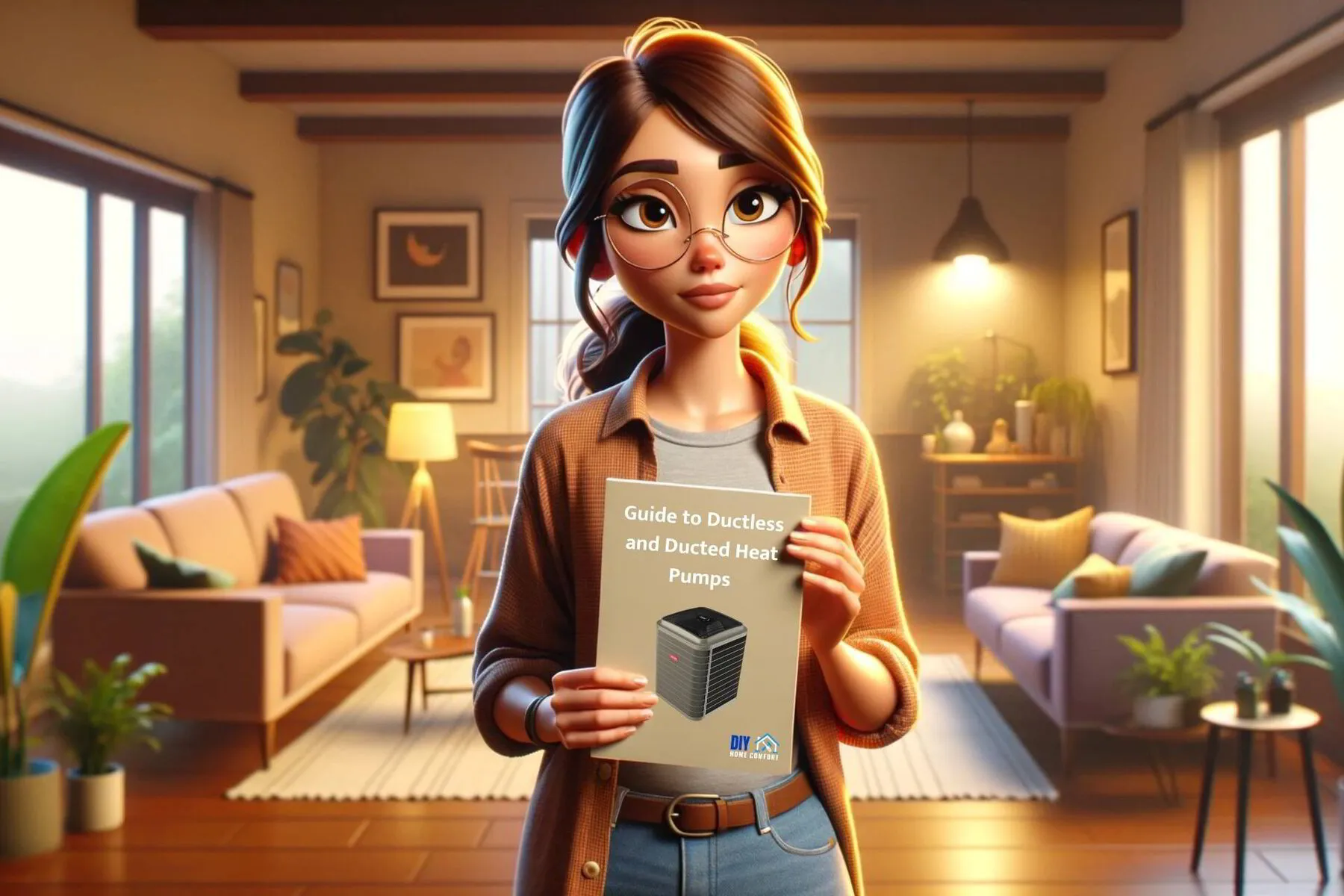When it comes to maintaining a comfortable home climate, choosing the right heat pump system is paramount. But with options like ductless and ducted heat pump systems on the table, how do you decide which one is the best fit for your home?
Well, it’s all about understanding the differences and weighing the pros and cons in the “ductless vs ducted heat pump” debate. Strap in as we guide you through the ins and outs of these two heat pump systems, helping you make an informed decision.
📘 Key Takeaways
- Efficiency and Energy Savings: Ductless systems are more energy-efficient and ideal for homes without existing ducts, while ducted systems can lose significant energy through duct leaks.
- Customization and Comfort: Ductless heat pumps allow individual room temperature control, whereas ducted systems use zoning for area-specific temperature management.
- Installation and Costs: Ductless heat pumps are generally less expensive and faster to install than ducted systems, especially in homes lacking pre-existing ductwork.
- Air Quality and Maintenance: Ductless systems offer superior air quality with less maintenance, while ducted systems require regular cleaning to maintain air quality and efficiency.
- Aesthetic Considerations and Home Compatibility: The choice between ductless and ducted systems depends on the home's layout and personal aesthetics, with ductless units being more visible and ducted systems offering a seamless look.
Understanding Ductless and Ducted Heat Pumps
Heat pumps, including air-source heat pumps and ground-source heat pumps, function by shifting heat rather than generating it internally, which makes them a highly efficient choice for heating and cooling.
Ducted heat pumps and ductless heat pumps are the two main types of heat pump systems. Each offers an efficient, reliable, cost-effective way to heat or cool a building.
Both have unique characteristics and applications, offering different advantages depending on your needs.
Ductless Heat Pumps
Imagine having a versatile system that offers both cooling and heating capabilities, maintaining a comfortable indoor environment throughout the year. That’s what a ductless heat pump, also known as a ductless mini-split system, provides.
These systems are connected by refrigerant lines, allowing for individual room temperature control without the dependence on ductwork. Sounds quite convenient, doesn’t it?
Beyond this, ductless heat pumps can function as a house's primary heating and cooling system. Their zoning capabilities allow for temperature adjustment in specific rooms or areas of your home, with individual thermostats for each air handler.
This offers improved comfort and energy efficiency. Add to that the longevity of these systems, with a well-maintained unit potentially having a lifespan of up to 20 years, and you’ve got a pretty strong contender on your hands.
Ducted Heat Pumps
Conversely, ducted heat pumps operate through an outdoor compressor and a central air handler to provide heated or cooled air. This conditioned air is then circulated throughout the house using existing ductwork. Sounds a tad more traditional, doesn’t it?
But don’t let the word ‘traditional’ fool you. Ducted heat pumps are known for their efficiency, often providing up to three times more energy than they consume. Plus, they excel in dehumidification compared to standard ducted central air conditioners.
From an aesthetic perspective, some might favor the unified appearance of ducted heat pumps over the more conspicuous indoor components of ductless systems. A ducted heat pump can be a superb choice, particularcreate a ly in homes with central air conditioning and well-maintained ductwork.
Energy Efficiency and Performance
When we’re talking about efficiency, ductless systems take the cake. Why? They don’t have ducts! That means no energy loss due to leaky ducts, which can amount to a whopping 25-30% in ducted systems.
Plus, they score high on the Heating Seasonal Performance Factor (HSPF), a metric used to assess the efficiency of a heat pump in heating mode.
This translates into improved performance, especially in regions with frequent cold snaps, like Atlantic Canada.
Energy Loss in Ducted Systems
While ducted systems have their merits, they can fall short regarding energy loss.
You see, air leakage and heat conduction through the duct walls are the main culprits, with typical energy loss due to leaks, holes, and loose connections in air-duct networks ranging from 25 to 40 percent. That’s a lot of wasted energy!
Besides increasing your heating costs, ducted heat pump system leakage forces the system to work harder to maintain the desired temperature, leading to increased energy consumption.
The escaped air causes the HVAC system to operate for longer periods and at higher intensity to meet the thermostat settings, ultimately resulting in decreased efficiency.
However, there are several methods to detect and prevent energy loss, such as:
- Leak tests on ducts
- Insulation checks inside the air handler
- Duct sealing and insulation
- Energy consumption pattern analysis
- The use of thermography to identify heat losses in mechanical systems
Advantages of Ductless Systems
Conversely, ductless systems excel in terms of energy efficiency. By eliminating ducts and utilizing inverter technology, they significantly reduce energy loss.
The direct delivery of conditioned air to the intended space helps reduce energy waste.
Plus, they generally have higher SEER scores than traditional HVAC systems, indicating their superior efficiency in cooling or heating with reduced energy consumption.
Hence, you obtain a comfortable home and savings on utility costs, proving advantageous on both fronts, wouldn’t you agree?
Installation and Costs
Let’s now shift focus to the installation process and the costs related to both ductless and ducted heat pump systems.
From the beginning, one should acknowledge that the ductless option is usually more cost-effective without pre-existing ducts. But to get a clearer picture, let’s break down the costs and process for each system.
Ductless Installation
The process of installing a ductless system typically takes about 2-3 hours, depending on the number of indoor and outdoor units to be installed.
The installation involves identifying the location of the indoor and outdoor units, installing the units, connecting refrigerant lines and electrical wiring, mounting the indoor unit, and testing the system. Sounds straightforward, right?
It can be, provided you’re equipped with an adjustable wrench, drill/driver, hole saw, level, micron gauge, flaring tools, vacuum pump, mounting brackets, and torque wrenches.
However, like any installation, there might be potential challenges, such as incorrect installation, freezing during winter, and water leaks.
The cost of installing a ductless system can vary from $1,800 to $28,000, depending on factors such as the system’s size, number of zones, and the complexity of the installation (1).
Despite these potential challenges, ductless systems offer a range of financing, rebate options, and comprehensive warranty choices, making them attractive.
Ducted Installation
On the other hand, installing a ducted system involves preparing the site, determining the correct ductwork size, consulting with contractors, and the actual installation.
The process can be more complex than a ductless installation, particularly if ductwork needs to be installed or modified. The materials required include the heat pump unit, ductwork, insulation, electrical wiring, refrigerant lines, and mounting brackets.
But as with any installation, challenges can arise. These can include:
- Duct leakage
- Refrigerant leaks or issues
- Contamination of heat pump components
- Potential airflow obstructions
Despite these potential obstacles, a ducted heat pump system can be a favorable option for a residence with central air conditioning and well-maintained ductwork, as it can use the existing infrastructure.
Air Quality and Maintenance
With respect to air quality, ductless systems have a minor advantage. They eliminate the accumulation of dust and pollutants in ducts, resulting in cleaner air.
On the contrary, ducted systems require regular maintenance to maintain optimal air quality and prevent the buildup of dust and pollutants in the ducts.
Let’s examine these aspects in more detail.
Ductless System Air Quality
The absence of ducts in a ductless system offers several benefits:
- Prevents the accumulation of dust and other pollutants, as there is no network of ductwork for these pollutants to build up and be circulated through the system
- Provides cleaner, fresher air
- Some ductless systems incorporate filters that effectively eliminate dust, pollen, and other particles from the air.
- Certain systems offer self-cleaning features that contribute to sustaining optimal indoor air quality.
Ductless systems should be serviced and thoroughly cleaned annually to maintain this high air quality. This not only ensures clean, fresh air but also helps maintain the efficiency and longevity of the system.
Ducted System Air Quality and Maintenance
Conversely, at least bi-annually, ducted systems need regular cleaning and maintenance to optimize performance, prevent problems, and maintain air quality standards.
This includes:
- Cleaning or replacement of the filter
- Inspection and cleaning of the ducts and indoor coil for dirt
- Scheduling routine maintenance with a professional HVAC technician to maintain efficient operation.
What occurs when maintenance is insufficient? Well, the following issues can occur:
- Dirty filters and coils
- Refrigerant leaks
- Duct leaks
- Dirty ductwork
- Clogged drain pipes
- Water leaks
- Pilot or ignition problems
- Increased levels of allergens in the air
- Energy losses due to air leakage
- Risk of hazardous gases entering the home
Therefore, recommended maintenance should be done at least once a year to ensure efficient performance.
Customization and Zoning Capabilities
Comfort is paramount in heating and cooling your home, and the ability to control the temperature in particular areas within your residence can heighten overall comfort. This is where zoning in HVAC systems comes in.
Both ductless and ducted heat pump systems offer zoning capabilities but do so in slightly different ways. Let’s take a closer look.
Ductless Zoning
The beauty of ductless zoning lies in its ability to control individual room temperature.
This is achieved through the use of multiple indoor units connected to a single outdoor unit, each zone or room having its temperature controlled individually, without the need for ductwork.
This enhances comfort and delivers notable energy conservation and improved efficiency in heating and cooling systems.
But what does this mean for you? Imagine being able to adjust the temperature in your living room without affecting the bedrooms. Or turning off the heating in an unoccupied guest room to save energy.
You can customize your home’s heating and cooling with ductless zoning to meet your specific needs.
Ducted Zoning
Ducted zoning operates through the use of:
- Zone dampers that are integrated into the ductwork
- These dampers can regulate airflow by opening or closing, enabling control over air distribution to various sections or zones within the household.
- This facilitates individualized comfort settings for each zone and enhances energy efficiency by directing air away from unoccupied areas.
- The necessary equipment for implementing ducted zoning includes thermostats, a zoning control panel, and dampers.
Imagine being able to control the temperature in your master bedroom independently from the rest of the house.
Or turning up the heat in the living room without affecting the kitchen. You can enhance comfort and energy efficiency throughout your home with ducted zoning.
Ductless System Appearance
A standard ductless heat pump system consists of an indoor unit mounted on the wall or ceiling and an outdoor unit that encases the compressor and condenser.
These units are visible in a room, which can be a drawback if you prefer a more streamlined look. However, there are ways to minimize their impact.
For instance, homeowners can use custom covers that complement the room’s furniture, enhancing the overall aesthetics.
Additionally, there are opportunities for smart home integration, such as utilizing integrated controls to manage both ductless and traditional heating systems through a single interface or opting for easy installation on exterior walls to minimize interior impact.
Ducted System Appearance
In contrast, ducted heat pump systems offer a more built-in appearance. The indoor unit is concealed in the ceiling, or another hidden area of the home, and the vents and registers are seamlessly integrated into the home’s design.
You can even customize the vent covers to blend with your interior, ensuring a discreet appearance.
Regardless of whether you favor the sleek, contemporary appeal of a wall-mounted ductless unit or the unified appearance of a ducted system, there’s a heat pump system to match your aesthetic preference.
Choosing the Right System for Your Home
By this point, you should understand the main differences between ducted and ductless heat pump systems. But how do you decide which is best for your home? It’s all about considering your specific needs, preferences, and circumstances.
Let’s consider the key factors and advantages of consulting experts.
Factors to Consider
Several factors come into play when choosing between a ductless and a ducted heat pump. First and foremost, there’s cost.
A ductless heat pump system typically ranges from $1,800 to $28,000, whereas a ducted system averages between $6,000 and $20,000. If it's a geothermal heat pump, costs can go up to an astronomical $40,000 (2).
However, installing a ducted system may result in higher expenses if ductwork installation or modification is required.
Therefore, it’s important to consider installation costs, equipment expenses, and any potential additional costs.
Next, there’s energy efficiency. As we’ve discussed, ductless systems are generally more energy efficient due to their absence of ducts and use of inverter technology. This can lead to lower energy bills in the long run.
Finally, you should consider the layout of your home. If your home has pre-existing ductwork, a ducted system could be a more economical choice.
Conversely, if your home lacks ductwork or if the ductwork is in poor condition, a ductless system could be a better fit.
Expert Consultation
While conducting your research and considering your specific needs is important, consulting an HVAC professional is also strongly recommended. These experts can offer tailored guidance based on the unique characteristics of your home.
They can evaluate your home’s size, insulation levels, energy efficiency needs, and budget limitations to recommend the most suitable system.
Moreover, they can assess your existing ductwork to determine its compatibility with a ducted heat pump or assess if a ductless system would be more suitable.
In addition to offering professional guidance, HVAC professionals are trained to handle the installation process.
They can ensure that your system is installed correctly and efficiently, helping to maximize its performance and lifespan. So, when choosing your heat pump system, don’t underestimate the value of expert advice.
Summary
In conclusion, both ductless and ducted heat pump systems offer unique advantages that make them suitable for different scenarios.
Ductless systems offer superior energy efficiency and individual room temperature control and are generally more cost-effective to install in homes without existing ductwork.
On the other hand, ducted systems provide a more integrated look, are efficient in their own right, and can be a good choice for homes with existing ductwork.
Ultimately, the best system for your home will depend on a variety of factors, including your budget, energy efficiency goals, home layout, and personal preferences. Whatever your needs may be, there’s a heat pump system out there that’s just right for you.
Want to learn more about your HVAC system? Check out our other HVAC articles!
Scott Harding
Scott is the main author of DIY Home Comfort. He's also an experienced HVAC technician that enjoys home renovation and spending time with his family. You can find out more about him here.
References
- How Much Does It Cost to Install a Ductless Air Conditioner? - Fixr.com
- Ductless Mini Split vs Ducted Heat Pump: What are the Differences - Unique Heating and Cooling
Frequently Asked Questions
Why does my heat keep switching to auxiliary heat?
It looks like your AUX heat setting is coming on because the weather outside is freezing or the thermostat is set too high. It's also possible that a part of the heat pump is malfunctioning.
What temperature should auxiliary heat come on?
Auxiliary heat will turn on when the outside temperature is around 35-40 degrees F, and the indoor temperature is 3 degrees cooler than the thermostat setting.
How long can auxiliary heat run?
Auxiliary heat should only run until your home reaches the temperature set on the thermostat.
Is it bad if auxiliary heat comes on HVAC?
It's normal for AUX heat to come on in your HVAC system when the indoor temperature is 3 degrees colder than the thermostat setting. Most of the time, this heating system works as it should and needs a little extra power to get your home back to the desired temperature.
What is the purpose of auxiliary heat?
Auxiliary heat provides additional warmth when a heat pump cannot maintain the thermostat's temperature setting, acting as a supplemental heating system.










